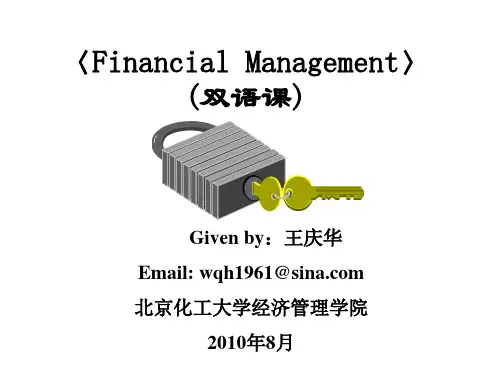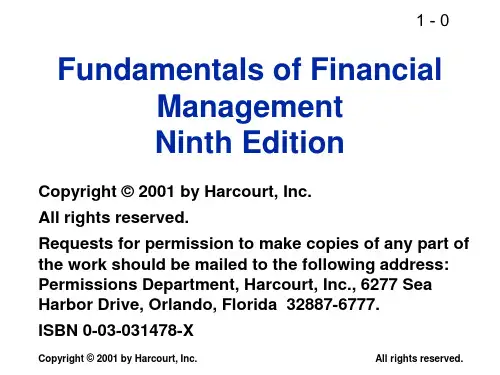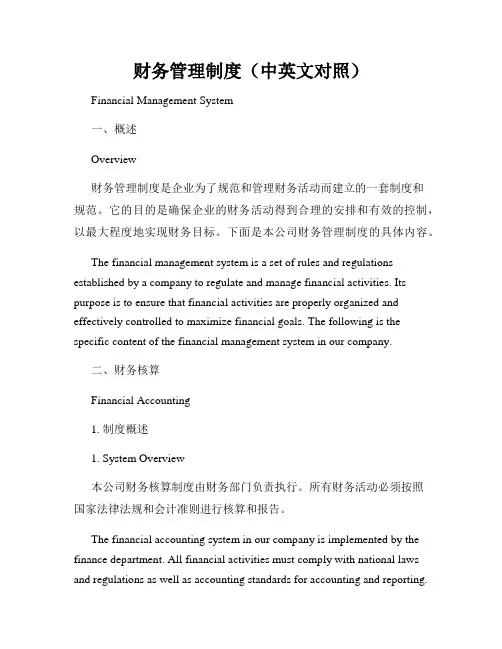财务管理英文
- 格式:ppt
- 大小:7.39 MB
- 文档页数:370


财务管理的概念:Concerns the acquisition, financing, and management of assets with some overall goal in mind. Investment decisions,Financing decisions,Asset management decisions。
The Goal of the Firm:Maximization of Shareholder Wealth:Value creation occurs when we maximize the share price for current shareholders.公司组织形式:Sole Proprietorships:Advantages:Simplicity,Low setup cost,Quick set up,Single tax filing on individual form。
Disadvantages:Unlimited liability,Hard to raise additional capital,Transfer of ownership difficulties,Partnerships (general and limited) Advantages:Can be simple,Low setup cost, higher than sole proprietorship,Relatively quick setup,Limited liability for limited partners。
Disadvantages:Unlimited liability for the general partner,Difficult to raise additional capital, but easier than sole proprietorship,Transfer of ownership difficultiesCorporations :Advantages:Limited liability,Easy transfer of ownership,Unlimited life,Easier to raise large quantities of capital。





关于财务管理的英文单词IntroductionFinancial management is a crucial aspect of running a business or managing personal finances. Understanding the vocabulary related to financial management is essential for effective communication and decision-making in this field. In this document, we will explore a comprehensive list of English words that are frequently used in the context of financial management.Basic Financial Terminology1.Assets: Resources owned by an individual or business, such as cash, investments, or property.2.Liabilities: Debts or financial obligations owed by an individual or business, including loans, credit card debt, or mortgages.3.Equity: The value of an individual’s or business’ assets minus its liabilities. It represents the ownership interest in a company.4.Income: The money earned from various sources, such as salaries, investments, or business revenue.5.Expenses: The costs incurred by an individual or business, including rent, utilities, salaries, and other operational expenses.6.Budget: A financial plan that outlines expected income and expenses over a specific period. It helps individuals and businesses manage their finances and achieve their financial goals.Financial Statements7.Balance Sheet: A financial statement that provides a snapshot of an indi vidual’s or business’ financial condition, showing assets, liabilities, and equity at a specific point in time.8.Income Statement: Also known as a profit and loss statement, it shows an individual’s or business’ revenue, expenses, and net profit or loss over a specific period. It helps evaluate performance and profitability.9.Cash Flow Statement: A statement that tracks the movement of cash into and out of an individual’s or business’ accounts over a specific period. It helps analyze liquidity and cash management.Financial Analysis10.Ratio Analysis: The process of evaluating financial statements using various ratios to assess an individual’s or business’ performance, liquidity, profitability, and solvency.11.Return on Investment (ROI): A metric used to evaluate the profitability of an investment. It measures the return or gn on an investment relative to the cost of the investment.12.Gross Margin: The difference between revenue and the cost of goods sold, expressed as a percentage. It indicates how efficiently a company produces its goods or services. Present Value (NPV): The present value of cash inflows minus the present value of cash outflows over a specific period. It helps individuals and businesses determine the profitability of an investment.14.Break-Even Point: The level of sales at which total revenue equals total expenses. It indicates the minimum level at which a business must operate to avoid losses.15.Risk Management: The process of identifying, assessing, and prioritizing risks in order to minimize their impact on financial goals. It involves developing strategies to mitigate risks and protect assets. Investment and Financial Instruments16.Stocks: Represent ownership in a company and are traded on stock exchanges.17.Bonds: Debt instruments issued by governments or corporations. Investors lend money to the issuer in exchange for regular interest payments and the return of the principal amount at maturity.18.Mutual Funds: Investment vehicles that pool money from multiple investors to invest in a diversified portfolio of stocks, bonds, or other securities.19.Diversification: Spreading investments across different assets or asset classes to reduce risk.20.Derivatives: Financial contracts whose value is derived from an underlying asset, such as options, futures contracts, or swaps. They are used to manage risk or speculate on price movements.ConclusionThis document has presented a comprehensive list of English words related to financial management. Understanding these terms is essential for effectively managing personal finances or running a business. Constant learning and staying updated with financial terminology can help individuals and businesses make informed decisions and improve their financial well-being.。

财务管理制度英文范文Financial Management SystemIntroductionFinancial management is an essential part of every organization, regardless of its size or nature. A well-designed and properly implemented financial management system allows an organization to effectively monitor and control its financial operations, make informed decisions, and ensure compliance with laws and regulations.This document outlines the financial management system of XYZ Company, providing guidelines and procedures to ensure the efficient and effective management of financial resources. The system covers key areas such as budgeting, accounting, cash management, financial reporting, and internal controls.1. Budgeting1.1. Objectives- Ensure effective allocation of financial resources to achieve organizational goals- Provide a basis for financial planning and decision-making- Control expenditure and prevent overruns1.2. Process- Prepare an annual budget based on inputs from various departments and stakeholders- Review and approve the budget by the management team- Monitor budget performance on a regular basis and take corrective actions when necessary- Conduct periodic budget reviews and adjustments, if required- Encourage the participation of relevant departments to promote ownership and accountability2. Accounting2.1. Chart of Accounts- Maintain a standardized chart of accounts to ensure consistency in financial reporting- Update the chart of accounts as needed to reflect changes in business operations or regulatory requirements2.2. Recording of Transactions- Record all financial transactions accurately, promptly, and in accordance with generally accepted accounting principles (GAAP) - Implement a double-entry accounting system to maintain proper books of accounts- Segregate duties to prevent conflicts of interest and ensure internal controls2.3. Financial Statements- Prepare accurate and reliable financial statements (income statement, balance sheet, and cash flow statement) on a monthly, quarterly, and annual basis- Ensure compliance with applicable accounting standards and legal requirements- Present financial statements to the management team for review and approval3. Cash Management3.1. Objectives- Optimize cash flow to meet operational needs and financial obligations- Minimize idle cash and associated costs, such as bank charges and interest expenses- Safeguard cash against theft or misappropriation3.2. Procedures- Develop cash forecasts to estimate daily, weekly, and monthly cash requirements- Maintain effective controls over cash receipts and disbursements - Establish clear and documented procedures for approving and processing payments- Periodically review banking arrangements and negotiate favorable terms and conditions4. Financial Reporting4.1. Internal Reports- Generate internal reports to provide management with timely and accurate financial information for decision-making- Examples include budget variance reports, management accounts, and key performance indicators (KPIs)4.2. External Reports- Prepare financial reports for external stakeholders, such as shareholders, lenders, and regulators- Ensure compliance with legal and regulatory requirements, such as annual financial statements and tax filings- Present accurate and transparent financial information to maintain credibility and trust5. Internal Controls5.1. Objectives- Safeguard company assets from loss, theft, or misuse- Prevent errors, fraud, and irregularities in financial transactions - Ensure compliance with laws, regulations, and internal policies 5.2. Measures- Implement segregation of duties to avoid concentration of power and enhance accountability- Conduct regular internal audits to assess the effectiveness of controls- Implement a robust system of checks and balances to detect and prevent errors and fraud- Provide training and awareness programs to employees regarding their roles and responsibilities in maintaining internal controls ConclusionA robust financial management system is critical for the success and sustainability of any organization. XYZ Company is committed to implementing and adhering to the guidelines and procedures outlined in this document to ensure efficient utilization of financial resources, accurate financial reporting, and strong internal controls. Regular review and improvement of the systemwill be conducted to adapt to changing business needs and regulatory requirements.。



财务管理制度(中英文对照)Financial Management System一、概述Overview财务管理制度是企业为了规范和管理财务活动而建立的一套制度和规范。
它的目的是确保企业的财务活动得到合理的安排和有效的控制,以最大程度地实现财务目标。
下面是本公司财务管理制度的具体内容。
The financial management system is a set of rules and regulations established by a company to regulate and manage financial activities. Its purpose is to ensure that financial activities are properly organized and effectively controlled to maximize financial goals. The following is the specific content of the financial management system in our company.二、财务核算Financial Accounting1. 制度概述1. System Overview本公司财务核算制度由财务部门负责执行。
所有财务活动必须按照国家法律法规和会计准则进行核算和报告。
The financial accounting system in our company is implemented by the finance department. All financial activities must comply with national laws and regulations as well as accounting standards for accounting and reporting.2. 财务报表2. Financial Statements按照国家相关规定和会计准则,财务部门将每年编制并及时发布财务报表,包括资产负债表、利润表和现金流量表等。
财务管理的英文怎么说简单的说,财务管理是组织企业财务活动,处理财务关系的一项经济管理工作。
那么你知道财务管理用英文怎么说吗?下面店铺为大家带来财务管理的英文说法和相关英语例句,供大家阅读学习。
财务管理的英文说法1:financial management英 [faɪˈnænʃ(ə)l ˈmænidʒmənt]美 [faɪˈnænʃ(ə)l ˈmænɪdʒmənt]财务管理的英文说法2:management through finance英 [ˈmænidʒmənt θru: faiˈnæns]美 [ˈmænɪdʒmənt θru fəˈnæns]财务管理相关英文表达:国际财务管理师 International Finance Manager财务管理系统 financial management system财务管理组织 financial management organization财务管理与分析 Financial Management and Analysis家庭财务管理系统 Family Financial Management财务管理英文说法例句:1. In running a company, strict financial management means everything.经营一家公司, 严格的财务管理是至关重要的.2. The company was skillfully financed.这个公司的财务管理得很得法.3. Financial controls were given to priority.他们把财务管理当成头等大事.4. It also provides the ERP solution for the financemanagement system.提出了ERP在财务管理系统的解决方案.5. Financial management is key in any company or enterprise.在任何公司和企业单位中财务管理是关键.6. The perfect foreign trade enterprise supplies the chain the financial control.完善外贸企业供应链的财务管理.7. My assignment of strategy Financial Management is due today.我的转让的战略财务管理,是今天上交.8. Corporate enterprise, there are three levels of financial management.公司制企业财务管理存在着三个层次.9. Bachelor degree or above, majored in accounting, finance management or other related.大学本科学历,会计专业、财务管理专业.10. Investment decision - making is a substantial portion of enterprise finance management.投资决策是企业财务管理中的一个重要部分.11. B 2 C e - commerce system, client relationship management system, financial system, Internet marketing system.B2C电子商务系统、客户关系管理系统、财务管理系统、网络营销系统.12. Financing is an eternal topic in business development and financial management.融资是企业经营发展和财务管理的永恒话题.13. At least 3 years experiences at department managerial level . 4.具有三年以上国际物流行业财务管理经验.14. Financial management is guided by a framework ofguidelines, limits and benchmarks.财务管理是遵循一个框架,指导方针, 限制和基准.15. Real estate finance and investment, Financial Management, Project finance, etc.房地产融资与投资(双语) 、财务管理(双语) 、项目融资等.。
武汉大学MBA《财务管理》教学大纲(该表由任课教师填写并与教学日历于上课前半月内提交给中心)一、课程简介1.课程名称:中文:财务管理英文:Financial Management2.开课时间:2013年3月29日至4 月2 日3.学时:364.任课教师姓名、职称:唐建新教授5.教师单位:会计系二、课程目标和任务6.本课程目标是,通过课堂教学与案例分析讨论,帮助学员:明确企业财务管理最优目标,树立企业财务管理正确观念,掌握企业财务管理科学方法,培养能够胜任企业财务管理中高级职务的工作能力;掌握时间价值与风险价值计量、现金流量分析方法,为投资决策活动服务;掌握资本成本计量、资本结构调整方法,为筹资决策活动服务;掌握股利分配政策,为分配决策活动服务;掌握经营杠杆和财务杠杆分析工具、经济增加值和市场增加值计量方法,为创造企业价值活动服务;掌握企业并购、重组、风险投资等综合财务管理活动的规律,为企业资本经营服务;掌握透过财务报告解读企业财务状况、经营成果、现金流量情况及盈利能力、偿债能力、资产利用效率、抵御风险能力、可持续价值创造能力分析方法,为评价与改进相关财务政策服务。
7.本课程任务是,通过课堂教学与案例分析讨论:完成财务管理在企业经营管理中的定位与组织、财务管理目标选择的教学;完成时间价值观念及其在长期证券估价、资产和企业价值评估中应用的教学;完成企业价值创造管理、企业风险管理的教学;完成风险价值观念及其在资本市场风险与收益关系确认、投资组合理论与资本资产定价模型教学;完成企业投资资本预算及其投资决策时间价值、风险价值分析以及投资盈亏平衡、敏感性分析教学;完成企业筹资渠道与方式选择、资本成本计量、经营杠杆与经营风险和财务杠杆与财务风险分析、企业价值理论以及资本结构改进教学;完成企业分配理论与政策以及股票股利与股票分割、现金股利与股票回购分析教学;完成企业并购、重组、风险投资等资本经营理论与实务教学;完成企业财务报告全息解读教学。
记帐:Bookkeeping Service对帐:Auditing Service联行:Associated Banks Service 或Affiliated Banks Service(我还是不明白这与5有何区别,但Associated和Affiliated不是动词原形,是形容词)代理业务: Agency Service银行卡接柜:Inter-Bank Bankcard Business Service现金审批:Cash Approval Service开销户: Account Opening/Closing Service开户的标牌还可以用:New Account/New Clientbig macs, big/large-cap stock, mega-issue 大盘股offering, list 上市bourse 证交所Shanghai Exchange 上海证交所pension fund 养老基金share 股票valuation 股价underwriter 保险商government bond 政府债券saving account 储蓄账户equity market 股市shareholder 股东delist 摘牌inventory 存货traded company, trading enterprise 上市公司market fundamentalist 市场经济基本规则damage-control machinery 安全顾问efficient market 有效市场opportunistic practice 投机行为entrepreneur 企业家cook the book 做假账regulatory system 监管体系portfolio 投资组合money-market 短期资本市场capital-market 长期资本市场volatility 波动diversification 多元化real estate 房地产option 期权call option 看涨期权put option 看跌期权merger 并购arbitrage 套利Securities and Exchange Commission 〈美〉证券交易委员会dollar standard 美元本位制budget 预算deficit 赤字bad debt 坏账macroeconomic 宏观经济fiscal stimulus 财政刺激a store of value 保值transaction currency 结算货币forward exchange 期货交易intervention currency 干预货币Treasury bond 财政部公债pickup in price 物价上涨Federal Reserve 美联储inflation 通货膨胀deflation 通货紧缩tighter credit 紧缩信贷monetary policy 货币政策foreign exchange 外汇spot transaction 即期交易forward transaction 远期交易quote 报价常见银行英语词汇account number 帐目编号depositor 存户pay-in slip 存款单a deposit form 存款单a banding machine 自动存取机to deposit 存款deposit receipt 存款收据private deposits 私人存款certificate of deposit 存单deposit book, passbook 存折credit card 信用卡principal 本金overdraft, overdraw 透支to endorse 背书endorser 背书人to cash 兑现to honor a cheque 兑付to dishonor a cheque 拒付to suspend payment 止付cheque,check 支票cheque book 支票本crossed cheque 横线支票blank cheque 空白支票rubber cheque 空头支票cheque stub, counterfoil 票根cash cheque 现金支票traveler's cheque 旅行支票cheque for transfer 转帐支票outstanding cheque 未付支票canceled cheque 已付支票forged cheque 伪支票Bandar's note 庄票,银票banker 银行家president 行长savings bank 储蓄银行Chase Bank 大通银行National City Bank of New York 花旗银行Hongkong Shanghai Banking Corporation 汇丰银行Chartered Bank of India, Australia and China 麦加利银行Banque de I'IndoChine 东方汇理银行central bank, national bank, banker's bank 中央银行bank of issue, bank of circulation 发行币银行commercial bank 商业银行,储蓄信贷银行member bank, credit bank 储蓄信贷银行discount bank 贴现银行exchange bank 汇兑银行requesting bank 委托开证银行issuing bank, opening bank 开证银行advising bank, notifying bank 通知银行negotiation bank 议付银行confirming bank 保兑银行paying bank 付款银行associate banker of collection 代收银行consigned banker of collection 委托银行clearing bank 清算银行local bank 本地银行domestic bank 国内银行overseas bank 国外银行unincorporated bank 钱庄branch bank 银行分行trustee savings bank 信托储蓄银行trust company 信托公司financial trust 金融信托公司unit trust 信托投资公司trust institution 银行的信托部credit department 银行的信用部commercial credit company(discount company) 商业信贷公司(贴现公司)neighborhood savings bank, bank of deposit 街道储蓄所credit union 合作银行credit bureau 商业兴信所self-service bank 无人银行land bank 土地银行construction bank 建设银行industrial and commercial bank 工商银行bank of communications 交通银行mutual savings bank 互助储蓄银行post office savings bank 邮局储蓄银行mortgage bank, building society 抵押银行industrial bank 实业银行home loan bank 家宅贷款银行reserve bank 准备银行chartered bank 特许银行corresponding bank 往来银行merchant bank, accepting bank 承兑银行investment bank 投资银行import and export bank (EXIMBANK) 进出口银行joint venture bank 合资银行money shop, native bank 钱庄credit cooperatives 信用社clearing house 票据交换所public accounting 公共会计business accounting 商业会计cost accounting 成本会计depreciation accounting 折旧会计computerized accounting 电脑化会计general ledger 总帐subsidiary ledger 分户帐cash book 现金出纳帐cash account 现金帐journal, day-book 日记帐,流水帐bad debts 坏帐investment 投资surplus 结余idle capital 游资economic cycle 经济周期economic boom 经济繁荣economic recession 经济衰退economic depression 经济萧条economic crisis 经济危机economic recovery 经济复苏inflation 通货膨胀deflation 通货收缩devaluation 货币贬值revaluation 货币增值international balance of payment 国际收支favourable balance 顺差adverse balance 逆差hard currency 硬通货soft currency 软通货international monetary system 国际货币制度the purchasing power of money 货币购买力money in circulation 货币流通量note issue 纸币发行量national budget 国家预算national gross product 国民生产总值public bond 公债stock, share 股票debenture 债券treasury bill 国库券debt chain 债务链direct exchange 直接(对角)套汇indirect exchange 间接(三角)套汇cross rate, arbitrage rate 套汇汇率foreign currency (exchange) reserve 外汇储备foreign exchange fluctuation 外汇波动foreign exchange crisis 外汇危机discount 贴现discount rate, bank rate 贴现率gold reserve 黄金储备money (financial) market 金融市场stock exchange 股票交易所broker 经纪人commission 佣金bookkeeping 簿记bookkeeper 簿记员an application form 申请单bank statement 对帐单letter of credit 信用证strong room, vault 保险库equitable tax system 等价税则specimen signature 签字式样banking hours, business hours 营业时间(Consumer Price Index) 消费者物价指数business 企业商业业务financial risk 财务风险sole proprietorship 私人业主制企业partnership 合伙制企业limited partner 有限责任合伙人general partner 一般合伙人separation of ownership and control 所有权与经营权分离claim 要求主张要求权management buyout 管理层收购tender offer 要约收购financial standards 财务准则initial public offering 首次公开发行股票private corporation 私募公司未上市公司closely held corporation 控股公司board of directors 董事会executove director 执行董事non- executove director 非执行董事chairperson 主席controller 主计长treasurer 司库revenue 收入profit 利润earnings per share 每股盈余return 回报market share 市场份额social good 社会福利financial distress 财务困境stakeholder theory 利益相关者理论value (wealth) maximization 价值(财富)最大化common stockholder 普通股股东preferred stockholder 优先股股东debt holder 债权人well-being 福利diversity 多样化going concern 持续的agency problem 代理问题free-riding problem 搭便车问题information asymmetry 信息不对称retail investor 散户投资者institutional investor 机构投资者agency relationship 代理关系net present value 净现值creative accounting 创造性会计stock option 股票期权agency cost 代理成本bonding cost 契约成本monitoring costs 监督成本takeover 接管corporate annual reports 公司年报balance sheet 资产负债表income statement 利润表statement of cash flows 现金流量表statement of retained earnings 留存收益表fair market value 公允市场价值marketable securities 油价证券check 支票money order 拨款但、汇款单withdrawal 提款accounts receivable 应收账款credit sale 赊销inventory 存货property,plant,and equipment 土地、厂房与设备depreciation 折旧accumulated depreciation 累计折旧liability 负债current liability 流动负债long-term liability 长期负债accounts payout 应付账款note payout 应付票据accrued espense 应计费用deferred tax 递延税款preferred stock 优先股common stock 普通股book value 账面价值capital surplus 资本盈余accumulated retained earnings 累计留存收益hybrid 混合金融工具treasury stock 库藏股historic cost 历史成本current market value 现行市场价值real estate 房地产outstanding 发行在外的a profit and loss statement 损益表net income 净利润operating income 经营收益earnings per share 每股收益simple capital structure 简单资本结构dilutive 冲减每股收益的basic earnings per share 基本每股收益complex capital structures 复杂的每股收益diluted earnings per share 稀释的每股收益convertible securities 可转换证券warrant 认股权证accrual accounting 应计制会计amortization 摊销accelerated methods 加速折旧法straight-line depreciation 直线折旧法statement of changes in shareholders’equity 股东权益变动表source of cash 现金来源use of cash 现金运用operating cash flows 经营现金流cash flow from operations 经营活动现金流direct method 直接法indirect method 间接法bottom-up approach 倒推法investing cash flows 投资现金流cash flow from investing 投资活动现金流joint venture 合资企业affiliate 分支机构financing cash flows 筹资现金流cash flows from financing 筹资活动现金流time value of money 货币时间价值simple interest 单利debt instrument 债务工具annuity 年金future value 终至present value 现值compound interest 复利compounding 复利计算pricipal 本金mortgage 抵押credit card 信用卡terminal value 终值discounting 折现计算discount rate 折现率opportunity cost 机会成本required rate of return 要求的报酬率cost of capital 资本成本ordinary annuity普通年金annuity due 先付年金financial ratio 财务比率deferred annuity 递延年金restrictive covenants 限制性条款perpetuity 永续年金bond indenture 债券契约face value 面值financial analyst 财务分析师coupon rate 息票利率liquidity ratio 流动性比率nominal interest rate 名义利率current ratio 流动比率effective interest rate 有效利率window dressing 账面粉饰going-concern value 持续经营价值marketable securities 短期证券liquidation value 清算价值quick ratio 速动比率book value 账面价值cash ratio 现金比率marker value 市场价值debt management ratios 债务管理比率intrinsic value 内在价值debt ratio 债务比率mispricing 给……错定价格debt-to-equity ratio 债务与权益比率valuation approach 估价方法equity multiplier 权益乘discounted cash flow valuation 折现现金流量模型long-term ratio 长期比率undervaluation 低估debt-to-total-capital 债务与全部资本比率overvaluation 高估leverage ratios 杠杆比率option-pricing model 期权定价模型interest coverage ratio 利息保障比率contingent claim valuation 或有要求权估价earnings before interest and taxes 息税前利润promissory note 本票cash flow coverage ratio 现金流量保障比率contractual provision 契约条款asset management ratios 资产管理比率par value 票面价值accounts receivable turnover ratio 应收账款周转率maturity value 到期价值inventory turnover ratio 存货周转率coupon 息票利息inventory processing period 存货周转期coupon payment 息票利息支付accounts payable turnover ratio 应付账款周转率coupon interest rate 息票利率cash conversion cycle 现金周转期maturity 到期日asset turnover ratio 资产周转率term to maturity 到期时间profitability ratio 盈利比率call provision赎回条款gross profit margin 毛利润call price 赎回价格operating profit margin 经营利润sinking fund provision 偿债基金条款net profit margin 净利润conversion right 转换权return on asset 资产收益率put provision 卖出条款return on total equity ratio 全部权益报酬率indenture 债务契约return on common equity 普通权益报酬率covenant 条款market-to-book value ratio 市场价值与账面价值比率trustee 托管人market value ratios 市场价值比率protective covenant 保护性条款dividend yield 股利收益率negative covenant 消极条款dividend payout 股利支付率positive covenant 积极条款financial statement财务报表secured deht担保借款profitability 盈利能力unsecured deht信用借款viability 生存能力creditworthiness 信誉solvency 偿付能力collateral 抵押品collateral trust bonds 抵押信托契约debenture 信用债券bond rating 债券评级current yield 现行收益yield to maturity 到期收益率default risk 违约风险interest rate risk 利息率风险authorized shares 授权股outstanding shares 发行股treasury share 库藏股repurchase 回购right to proxy 代理权right to vote 投票权independent auditor 独立审计师straight or majority voting 多数投票制cumulative voting 积累投票制liquidation 清算right to transfer ownership 所有权转移权preemptive right 优先认股权dividend discount model 股利折现模型capital asset pricing model 资本资产定价模型constant growth model 固定增长率模型growth perpetuity 增长年金mortgage bonds 抵押债券。
财务管理的英语介绍英文回答:Financial management is the process of planning, organizing, directing, and controlling the financial activities of an organization. It involves the efficient and effective use of financial resources to achieve the organization's goals. Financial management is a critical function in any organization, regardless of its size or industry. It helps organizations to maximize theirfinancial performance and achieve their long-term objectives.The primary goals of financial management are to:Ensure the availability of financial resources to meet the organization's needs.Allocate financial resources efficiently and effectively.Manage financial risks.Maximize the organization's financial performance.Financial management is a complex and multifaceted field. It involves a wide range of activities, including:Financial planning and analysis.Budgeting.Capital budgeting.Cash flow management.Investment management.Credit management.Risk management.Financial managers play a vital role in the success of any organization. They are responsible for making sound financial decisions that help the organization achieve its goals. Financial managers must have a strong understanding of financial principles and practices, as well as a deep understanding of the organization's business.中文回答:财务管理是指规划、组织、指导和控制组织财务活动的过程。
财务管理英文Introduction:Financial management is an essential aspect of any organization. It involves the management of money coming into the business and going out of the business. Financial managers are responsible for ensuring that an organization's financial resources are allocated appropriately, so as to achieve the organization's goals. In this paper, we will explore the key principles of financial management, discuss the major financial statements, and analyze the importance of financial planning and budgeting.Principles of Financial Management:The principles of financial management can be grouped into three broad categories: capital budgeting, capital structure, and working capital management. Capital budgeting refers to the process of allocating financial resources to long-term projects or investments. Capital structure, on the other hand, is concerned with the mix of long-term financing options used by the organization. Working capital management, finally, deals with the management of short-term assets and liabilities.Capital budgeting:Capital budgeting involves making investment decisions that will generate future cash flows. Essentially, it involves evaluating the potential returns of various investment options and selecting the most profitable investments. Key methods of capital budgeting include net present value (NPV), internal rate of return (IRR), and payback period. With NPV, the focus is on the present valueof future cash flows generated by an investment in relation to the initial investment. IRR, on the other hand, measures the rate of return of an investment, while payback period focuses on the time it takes to recoup the initial investment.Capital structure:The second principle of financial management is capital structure. This refers to the mix of long-term funding or financing options an organization uses to finance its operations. Most organizations use a combination of debt and equity financing. Debt financing involves borrowing money from lenders at a fixed interest rate, while equity financing involves offering investors ownership in the company in exchange for financial contributions. A crucial aspect of capital structure is determining the optimal mix of debt and equity financing that will minimize the company's overall cost of capital.Working capital management:The third principle of financial management is working capital management. This involves managing the day-to-day financial operations of the company, including maintaining an appropriate level of cash and other liquid assets to meet short-term obligations. Effective working capital management allows a company to maintain operations and meet financial obligations in the short term without resorting to high-interest borrowing.Financial Statements:One of the critical functions of financial management is to provide accurate and timely financial information to stakeholders. There are fourmajor financial statements companies use to communicate financial information: the balance sheet, income statement, cash flow statement, and statement of changes in equity.Balance sheet:The balance sheet presents a snapshot of the company's financial position by showing its assets and liabilities at a particular point in time. Assets include cash, buildings, equipment, and inventory, while liabilities include debts and other financial obligations.Income statement:The income statement shows how much revenue the company generated during a specific period and the expenses incurred to generate that revenue. After subtracting the expenses from revenues, the resulting figure represents net income or loss.Cash flow statement:The cash flow statement shows the inflow and outflow of cash during a particular period. It is divided into three categories: operating activities, investing activities, and financing activities.Statement of changes in equity:Finally, the statement of changes in equity shows any activity that affects shareholders' equity during the accounting period.Financial Planning and Budgeting:Financial planning and budgeting are critical components of financial management. Financial planning involves anticipating financial needs and developing a plan to meet them. Budgeting, on the other hand, involves allocating resources to specific activities, taking into account projected revenues and expenses.Benefits of financial planning and budgeting:Effective financial planning and budgeting provide several benefits to organizations. For instance, it helps organizations to prioritize investments, manage cash flow, identify potential risks and opportunities, and measure the success of their operations.Conclusion:In conclusion, financial management plays a critical role in the success of any organization. The principles of financial management include capital budgeting, capital structure, and working capital management. The major financial statements used to communicate financial information include the balance sheet, income statement, cash flow statement, and statement of changes in equity. Finally, financial planning and budgeting are essential components of financial management and enable organizations to prioritize investments, manage cash flow, identify potential risks and opportunities, and measure the success of their operations.。